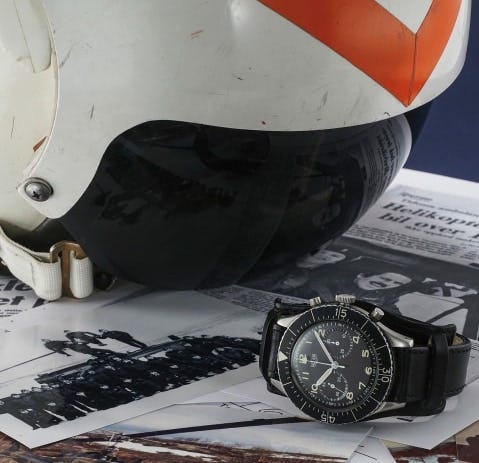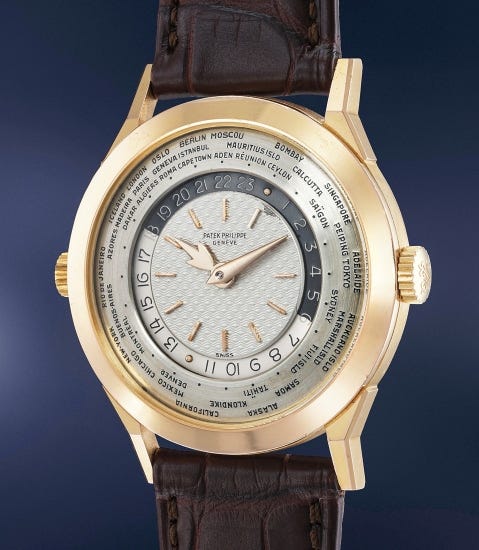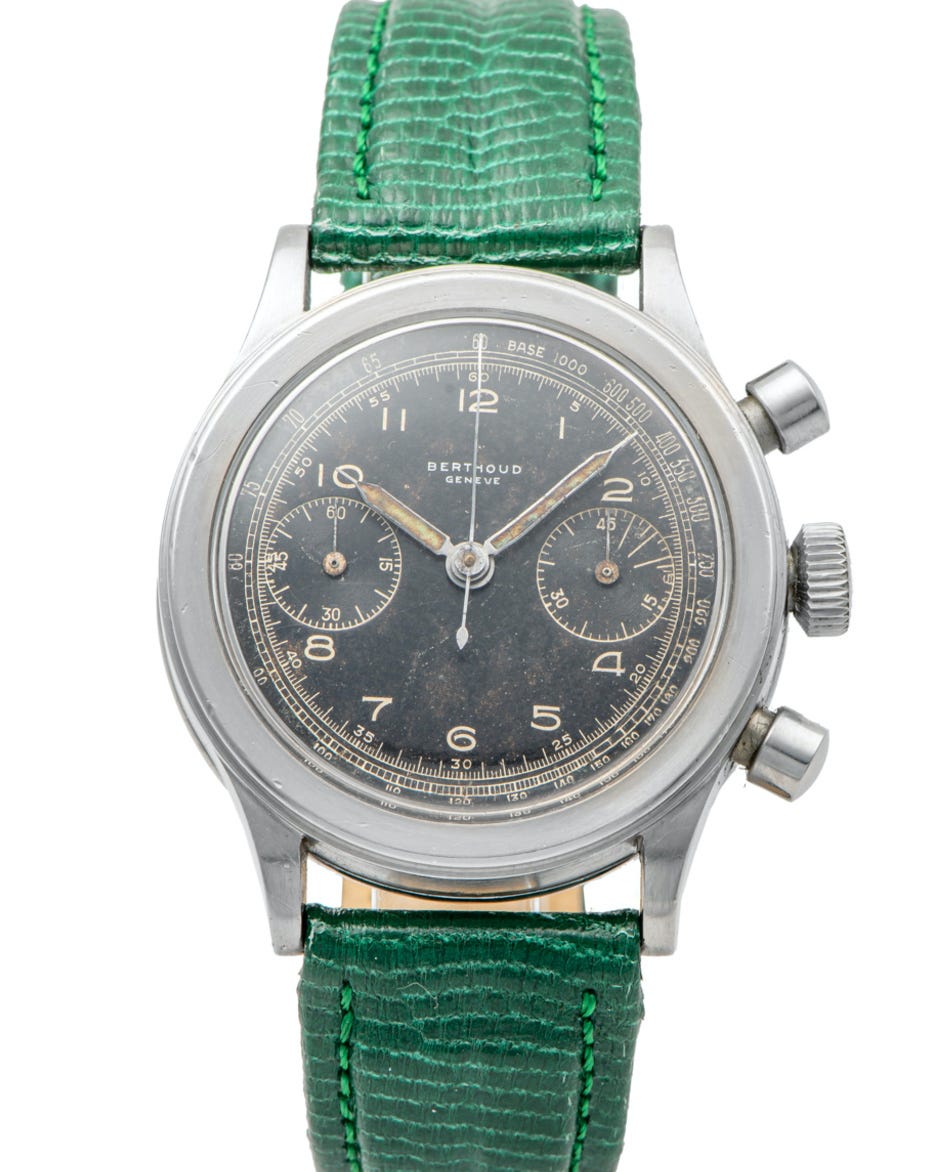A bit scattered this week, and the newsletter might reflect that. Featured are a few watches that caught my eye while perusing auction catalogs to distract myself from CNN’s magic wall. Hundreds (thousands?) of watches were offered at various auctions this weekend, so it’s impossible to give any sort of comprehensive summary of what sold; let’s zoom in on a few great stories instead.
Heuer ref. 1550 SG “Bundeswehr” for the Norwegian Air Force
“Bundeswehr” is deliberately placed in scare quotes in the title here, because this particular watch is something even better. The Heuer reference 1550 SG is most known as having been made for the German Bundeswehr in the 1970s. However, a small number of examples were also made for the Norwegian Air Force — the Luftforsvaret, as this one is engraved to show on the case back. It’s believed that as few as 50 of these Heuers were delivered to the Norwegian Luftforsvaret. This particular example is also stamped 74 on the back, indicating its year of delivery, when it was issued to helicopter pilot Lt. Tor-Gunnar Riise of the Royal Norwegian Air Force. This gentleman started his career as a flight engineer in 1977, flying the Bell UH-1B Iroquois (it’s a helicopter), and retiring in 2001 as a captain. Not only does the watch have excellent military provenance, it also looks to be in excellent condition. Sure, Phillips is known for bringing some of the most desirable, expensive watches to market (more on that below), but sometimes an ordinary watch with provenance and a story is better.
Better than all that, Capt. Riise offered a number of accessories with the lot: service report, copies of newspaper articles reporting Lt. Riise on duty, photos of Riise and his squadron and even his fighter helicopter helmet. The black dial, easily readable Arabic numerals and flyback chronograph function all make for a watch that’s unmistakeably produced for the military, and with the provenance to prove it. This particular Heuer is an example of a good watch that has an even better story that remains affordable compared to many higher-profile lots. It sold for CHF 20,160 this weekend.
Patek World Timer reference 2523
The cover lot from Phillips Geneva XII this weekend was a pink gold Patek World Timer reference 2523, one of 4 known with a guilloche dial (a similar example is on display at the Patek Philippe Museum). It didn’t disappoint, selling for CHF 4.99m (including buyer’s premium) after having an estimate of CHF 2-4m.
In fact, this same example (movement no. 724,317) was sold by Phillips back in 2016 for about $2.5m, when it was offered fresh to the market. It’s interesting to read that catalog entry from 2016, when Phillips wrote that it had been 18 years since a comparable watch had appeared at a public sale, and at the time this was only the second known example of a pink gold 2523 with a guilloche dial. Fast forward to 2020 and it’s now the fourth known example. The appearance of the watch in 2016 and again in 2020 illustrates both how (i) scholarship and discovery of watches is still evolving; and (ii) nowadays these watches seem to be offered for sale on a more regular basis. It’s a reminder that watch collecting is still a relatively young market.
The lot comes one year after another pink gold ref. 2523 set a record, becoming the most expensive watch ever sold in Asia, when Christie’s sold an example with a blue enamel dial double-signed by Gobbi Milano for nearly $9m in Hong Kong. This year’s example set another record of sorts: as Phillips’ Aurel Bacs slammed down the hammer, he noted it was the most expensive lot ever won by an online bidder, besting the previous record four times over. Nothing says 2020 like an online bidder dropping $5 million on a Patek Philippe World Timer, I suppose.
There’s not much else to say about such a superlative example of a supremely rare watch. A Patek World Timer is perhaps the king of complications, from the brand that does complications better than anyone else. Watchmaker Louis Cottier miniaturized his world timer invention — previously implemented in pocket watches — in the late 1930s, allowing Patek to squeeze it into a wristwatch. The reference 2523 was released a couple of decades later, featuring a new two-crown system to allow for the controlling of the city disk. Another small detail I love on this example: often, Chicago gets bested out for Mexico City on world timers (and rightfully so, Mexico City is awesome), but Chicago is seen on this ref. 2523.[1]
Berthoud Geneve Steel Chronograph from the 1950s
While most collectors probably know Universal Geneve, less known is sister brand Berthoud Geneve. Universal Geneve was founded in 1894 by two guys — Descombes and Perret — but Descombes died just three years later. After his friend’s death, Perret turned to Louis Berthoud to become his new partner in the growing watch business. At the time, Berthoud was a talented young watchmaker, so he was put in charge of complications for the young company. In fact, the partners briefly operated as Perret & Berthoud before switching to the Universal Watch Company Geneve after moving from Le Locle to Geneva. Berthoud’s talent as a watchmaker helped Universal lead the way as a manufacturer of chronographs throughout the early- and mid-20th century.
In addition to selling watches under the Universal name, UG also sold watches under the name Berthoud Geneve. Most likely offered as a budget option to more expensive Universal chronographs, vintage Berthoud watches might easily be mistaken for much more expensive timepieces but for the name on the dial. Vintage Berthouds are often found having been originally sold outside Switzerland in countries like the Netherlands, France, and South Africa. Inside a Berthoud chronograph, you’ll typically find a Universal Geneve caliber, often from its 285/385 series of movements, the stalwart of the brand’s chronograph lineup throughout the middle of the century.
Now, onto this particular Berthoud Geneve chronograph from the 1950s, offered in Antiquorum’s Geneva auction this weekend. Just looking at the specs, and you’ll see why it’s so good: 38mm stainless steel case, black dial, Universal Geneve chronograph caliber. But, with an estimate of CHF 3,500 to 5,500, it’s got the potential to be a downright steal. The caveat here is the condition: the black dial is far from perfect, and the hands have been re-lumed. However, the estimate seems potentially commiserate with these considerations. In pristine condition, an oversized, black dial chronograph from this era could easily stretch into the five figures. More than anything, this lot is an illustration that awesome, wearable chronographs from the 1940s-50s can still be found for well under $10,000. Check out Lot 165 from Antiquorum here.
Through the Wire
Inside Tudor HQ: How Tudor is revolutionizing watchmaking
Tons of fascinating insights about Tudor’s manufacturing process from this Wired article. Cards on the table, I think Tudor is perhaps the best modern watch brand operating at scale: innovative, true to its heritage, downright cool. Since rising from the dead in 2010 after a re-branding process, it’s totally unfair to think of Tudor as Rolex’s “younger sibling”. In so many ways, Tudor is pushing the Hans Wilsdorf Foundation forward, experimenting with retailer collabs and limited editions, reviving heritage models, and working with materials that Rolex simply won’t (bronze, titanium, etc.). The article even goes deep on the painstaking process of crafting Tudor’s fabric straps.
Tudor’s approach to watch production is even fundamentally different from Rolex’s: whereas Rolex tightly controls stock, Tudor says everything is built on order, requiring extreme efficiency at every step of the process. From Wired:
At the heart of the operation is The Church. Not a statement of faith – this is the nickname for the vast centralised vault of parts that forms the backbone of the assembly process. A fully automated system that holds millions of components over five subterranean storeys, it can deliver the necessary box of bits to Tudor’s assembly floor in less than a minute. The boxes arrive with the “train station” team, who manage the flow of parts in and out, and their distribution across the assembly room floor, where 60 technicians in white coats are steadily turning them into watches.
Tudor invests heavily in aspects of production that are neither glamorous or photogenic: improvements that the customer will never feel – except, perhaps, when it keeps the price below that of its rivals. One such example is a machine commissioned especially for the painstaking process of fitting hands to a dial – a critical procedure that can require six months’ training to perfect by hand, and can be a common cause of repetitive strain injuries. Tudor has a machine that switches between different models of watches on the assembly line, a task that used to take 30 minutes and now takes 30 seconds.
These are the types of articles that make one appreciate the innovations still happening in modern watchmaking.
Ben Clymer interview with A Media Operator
A worthwhile listen with Hodinkee founder Ben Clymer that provides an overview of the company’s now 12-year history and where it’s headed. He talks about the early years, getting watch and luxury brands to understand and advertise with Hodinkee online. He tells the story of one of his first conversations with a luxury exec, who began by telling a young Mr. Clymer that “the internet is for poor people.”
Over the last few years, Hodinkee has transitioned from a media company to an e-commerce company. Clymer says that far more than half of Hodinkee’s revenue comes from the e-commerce side, and that figure is only growing. He adds:
In many ways we represent what a brand could be or a media company could be. We are our own brand, we are creating something that is much more than commentary, we are also shaping products …. It’s a little bit like Supreme or Kith: It’s the idea that there’s this special joining of distinct brands to put their own spin on products.
As for the future of Hodinkee’s editorial content while the e-commerce business continues to grow? It’ll continue to transition to a commercial play:
“We will continue to add people that are more in-tune with our commercial objectives. These people will be editors or content creators, but they will understand that the future of this business is commerce. The structure won’t change dramatically, but this will become more a commercial play and less an editorial one.”
Listen, everyone seems to have an opinion about what Hodinkee is or what it should be; and that’s fair for a company that so heavily touts its “community.” But far be it from me — or any of us — to question the decisions of a brand that did ~$2.7m in Grand Seiko sales in a couple hours just last month, something I’m pretty sure Grand Seiko itself can’t even do.
🌴 Tropical Omega Speedmaster from Phillips. One more watch I wanted to highlight from Phillips Geneva XII: This gorgeous Omega Speedmaster CK2998-2. It’s vaguely reminiscent of the Speedmaster still on sale over at the Hodinkee Shop that I featured a couple weeks ago. But this one saw a ton of bidding action, eventually selling for CHF 100k.
🕺 Michael Jackson’s personal Richard Mille! (h/t Rich)🚪 Collectability interviews Kelly Yoch as she leaves her post as Tiffany’s Patek ambassador to a new position with Watches of Switzerland. 🧃 The Timex Q is such a good watch. On top of looking great, it’s endlessly remixable: The Huckberry x Timex ‘Cola’ is the latest example that just works. 🍺 USA Today profiles Matt Hranek and his Wm Brown Magazine.
Stick to Watches: If, somehow, you still want more politics, check out Eric Wind’s guide to all the watches of the Presidents, or the NY Times story on the Vulcain Cricket and U.S. Presidents.
Okay Ciao! - Tony
—
Rescapement is a weekly newsletter about watches, bringing horological secrets vintage and modern to your inbox every Sunday.
[1] It makes sense: Chicago was about 1.5x the size of Mexico City in 1950 (5.1m vs. 3.3m). While Mexico City’s size has nearly quadrupled since, Chicago’s population has remained relatively flat, perhaps making this ref. 2523 a cruel allegory for the decline of the great American city.







